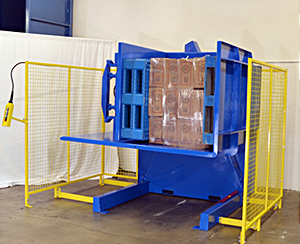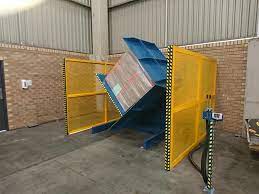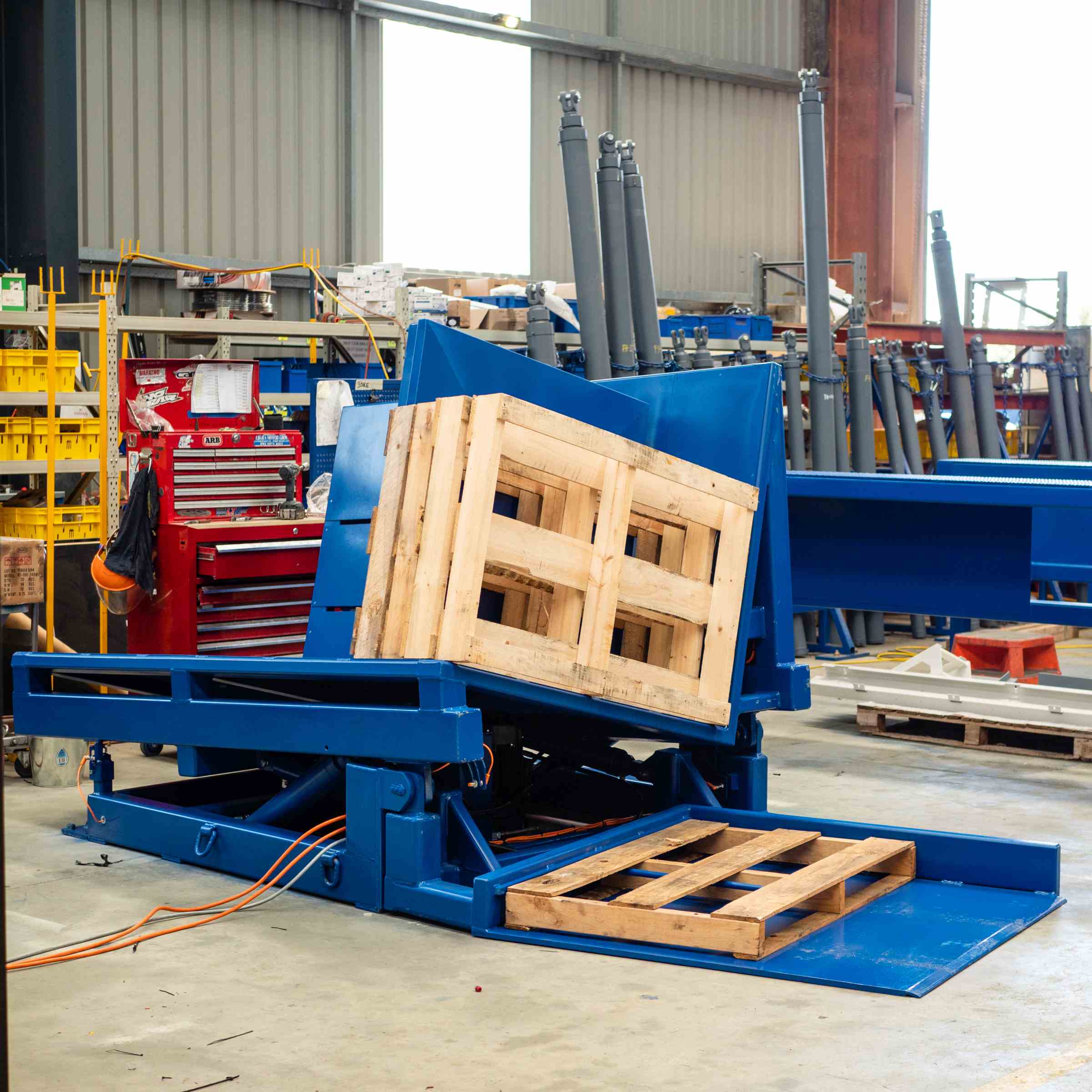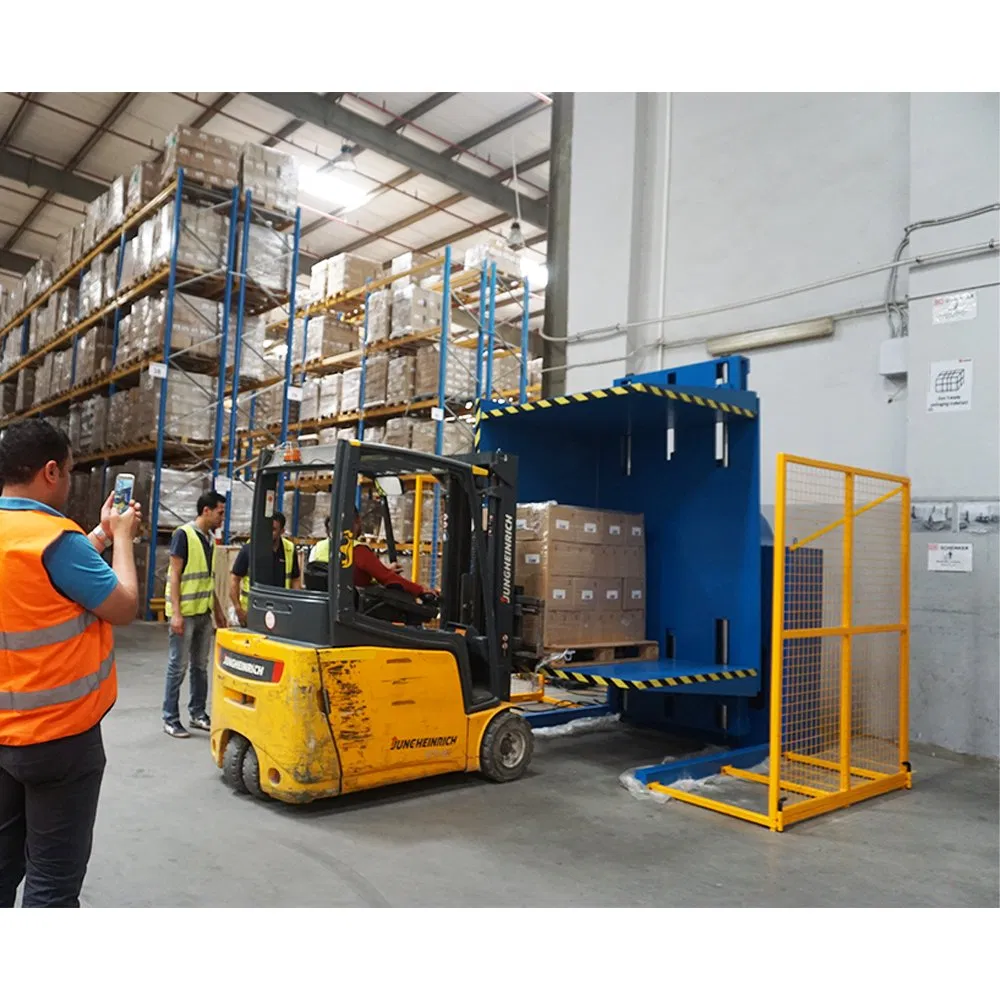Pallet Changing Machine: How to Handle Heat-Resistant Pallets Near Furnaces?
As an engineer who has spent his entire career around packing machinery, I’ve seen firsthand how a single, seemingly small process can create a major bottleneck. In a steel mill, one of the toughest challenges is handling materials near a furnace. The heat is intense, the products are heavy, and safety is non-negotiable. You might be using special heat-resistant pallets, but if your method of changing them is slow, manual, or unreliable, you are creating a point of failure right at the heart of your operation. This inefficiency directly impacts your output, increases risks for your team, and adds costs you can't afford, especially when dealing with aging equipment and fluctuating energy prices. The solution isn't just a better pallet; it's a better process, one that is automated, safe, and built to withstand the extreme conditions of your facility.
The most effective way to handle heat-resistant pallets near furnaces is to implement a specialized, heavy-duty pallet changing machine. This equipment is specifically engineered with heat-resistant components, a robust steel frame, and powerful clamping systems to automate the transfer of heavy loads like steel coils or parts. By doing this, you remove workers from the immediate danger zone, drastically reduce cycle times, and ensure a consistent, reliable flow of materials, protecting both your people and your product.

I understand the pressures you face. As someone who built a factory from the ground up, every investment had to be justified by its return, not just in dollars, but in safety and reliability. A pallet changer in a steel mill is not just another piece of equipment; it's a strategic asset. It directly addresses the core challenges of equipment reliability, cost control, and worker safety. Let’s dive deeper into the specific challenges of this environment and explore what makes a pallet changing solution truly effective for a demanding operation like yours.
What Makes Pallet Handling Near Furnaces So Challenging?
You might look at a pallet and think it's a simple part of your logistics chain. But when you place it next to a furnace, the entire equation changes. The environment transforms a straightforward task into a high-stakes engineering problem. You are not just moving a product; you are battling intense heat, massive weight, and constant safety risks. This combination can cause standard equipment to fail, pallets to degrade, and production to grind to a halt. This is a critical bottleneck that works directly against your goals of improving efficiency and reducing operational costs. To build a truly robust system, you must first respect and understand the unique challenges this environment presents.
Pallet handling near furnaces is exceptionally challenging due to three primary factors: extreme radiant and ambient heat that compromises material integrity, the immense and often concentrated weight of steel products, and the significant safety hazards posed to any personnel working in the area. These issues mean that standard pallets and manual handling methods are not just inefficient, but dangerously inadequate, requiring specialized, automated solutions.

Dive Deeper: The Triple Threat of Heat, Weight, and Safety
As an engineer, I love breaking down a complex problem into its core components. For pallet handling in a steel mill, the problem is a triangle of forces working against you. You must solve for all three, or the system will fail.
The Impact of Extreme Heat
The heat from a furnace is not just about high air temperature. The bigger enemy is radiant heat, which travels in a direct line and is absorbed by objects. This intense energy attacks your equipment in several ways.
- Pallet Degradation: A standard wooden pallet will dry out, become brittle, and can even ignite. A plastic pallet will warp, melt, and lose its structural integrity almost instantly. Even your heat-resistant pallets have a thermal limit and can be weakened by constant thermal cycling.
- Equipment Failure: The heat affects the pallet changer itself. Hydraulic fluid can overheat, losing viscosity and causing system failure. Seals and hoses can become brittle and crack. Electrical components and sensors can malfunction, leading to unplanned downtime. This is especially critical when you're working to improve the reliability of an operation with already aging equipment.
The Challenge of Heavy and Concentrated Loads
Steel products are the definition of a demanding load.
- Sheer Weight: Coils, billets, or forged parts can weigh several tons. The pallet changer must have the raw power in its hydraulics and motors to lift and manipulate this weight smoothly.
- Load Concentration: Unlike a pallet of uniformly distributed boxes, a steel coil concentrates its entire weight on a very small footprint. This creates immense stress on the pallet deck and the clamping mechanism of the pallet changer. The machine’s frame and its clamping plates must be engineered to handle these high-pressure points without flexing or failing.
The Overriding Importance of Safety
For any responsible factory owner, safety is the top priority. Manual handling near a furnace is one of the most dangerous jobs in a mill.
- Burn Risk: Proximity to the furnace and contact with hot products or pallets can cause severe burns.
- Heat Stress: The ambient temperature puts workers at risk of heat exhaustion and other heat-related illnesses.
- Ergonomic Injuries: Manually guiding or assisting with the movement of multi-ton loads, even with a forklift, puts immense strain on the human body.
Automating this process is not just an efficiency upgrade; it is a fundamental safety improvement. It moves your people out of harm's way.
Here is a simple breakdown of how different pallet materials perform in this environment.
| Pallet Material | Heat Resistance | Durability | Cost | Key Weakness Near a Furnace |
|---|---|---|---|---|
| Wood | Very Poor | Low | Low | Flammable, becomes brittle. |
| Standard Plastic | None | Medium | Medium | Melts and warps. |
| Composite | Medium | Medium | High | Can delaminate or degrade over time. |
| Steel | Excellent | Very High | Very High | Heavy, can warp if not designed for thermal cycling. |
Understanding these three challenges—heat, weight, and safety—is the first step. The next is to find a machine specifically engineered to overcome them.
Which Pallet Changer Features Are Critical for High-Temperature Environments?
So, you recognize the need for a pallet changer. The next critical step is understanding that not all machines are created equal. A standard pallet changer designed for a food processing plant or a distribution warehouse would have a very short and expensive life in your steel mill. I have seen companies make this mistake. They buy based on a spec sheet that looks good on paper but fails to account for the brutal reality of a high-heat, heavy-duty environment. This is a path to wasted capital, unexpected downtime, and the very safety risks you were trying to eliminate. It's a direct threat to your goal of achieving 95% equipment uptime. The key is to look for specific, deliberate engineering choices that show the machine was built for your world.
For high-temperature environments, the most critical features in a pallet changer are its structural and material specifications. This includes a heavy-gauge, reinforced steel frame, the use of high-temperature-rated components such as Viton seals for hydraulics and heat-shielded electrical wiring, and a powerful, adjustable clamping system capable of securely handling heavy, concentrated loads without causing product damage.

Dive Deeper: Engineering for Extreme Conditions
When my team and I at SHJLPACK design a machine for a tough industry like steel, we focus on the details that ensure long-term survival and performance. Think of it as building an armored vehicle, not a passenger car. Every component choice matters.
Heavy-Duty Structural Integrity
The foundation of the machine must be unshakable.
- Frame Construction: This starts with using thicker steel plates and structural tubes. All joints should be fully welded, not bolted, to create a rigid, unified structure that can resist the twisting forces of a multi-ton, off-center load.
- Reinforcements: Look for gussets and extra bracing at key stress points, particularly around the main pivot and the base of the clamping walls. This prevents fatigue and flex over millions of cycles. A machine that flexes will wear out its moving parts and lose precision.
High-Temperature Component Selection
This is where a supplier's expertise truly shows. Anyone can build a big steel box, but it's the small components that determine reliability in the face of heat.
- Hydraulic System: Standard hydraulic seals (often made of Buna-N) will fail quickly. The system must use high-temperature seals like Viton. Hydraulic hoses should be shielded or routed away from direct radiant heat. A properly sized hydraulic oil cooler is not an option; it's a necessity to maintain fluid viscosity and prevent pump damage.
- Electrical and Control Systems: Wires need high-temperature insulation. We often recommend placing the main electrical control cabinet away from the machine, outside the primary heat zone. If sensors must be near the heat, they need to be specified for high temperatures and potentially shielded. This kind of planning prevents the nuisance electrical faults that can plague production and are difficult to diagnose.
- Mechanical Parts: All bearings must be rated for the operating temperature and use the correct high-temperature grease. Standard grease will liquefy and run out, leading to bearing seizure.
A Powerful and Intelligent Clamping System
Handling steel requires a balance of power and control.
- Power: The clamping mechanism must be able to apply enough pressure to hold a heavy, slick steel coil securely during a full 90 or 180-degree rotation.
- Control: The pressure must be adjustable. Too much pressure can damage a finished product. The system should allow you to set different pressures for different products, ensuring both safety and quality. The clamping walls themselves should be thick and flat to distribute the pressure evenly.
When you evaluate a potential supplier, these are the details to discuss. Below is a checklist you can use.
| Feature Category | What to Look For | Key Question for the Supplier |
|---|---|---|
| Structure | Fully welded, heavy-gauge steel frame. | "What thickness of steel do you use for the main frame and clamping walls?" |
| Hydraulics | High-temperature (Viton) seals, oil cooler. | "What is the temperature rating on your hydraulic seals and hoses?" |
| Electrics | Heat-rated wiring, remote or cooled panel. | "How do you protect the electrical components from radiant heat?" |
| Clamping | Adjustable pressure control, robust actuators. | "Can you demonstrate how we can set and control the clamping pressure for different loads?" |
| Safety | Safety light curtains, physical guarding, E-stops. | "What safety systems are standard on this machine?" |
A supplier who can answer these questions with confidence and detail is one who understands your world.
How Can a Pallet Changer Improve Safety and Efficiency in a Steel Mill?
In any heavy industry, you are in a constant push-and-pull between maximizing production and ensuring the absolute safety of your team. Processes that require manual work in hazardous areas, like handling hot pallets near a furnace, are a major source of this conflict. Every time a worker has to get close to the heat or manually guide a heavy load, you are accepting a risk. At the same time, this manual work is almost always slower and less consistent than an automated process, creating a drag on your efficiency. This conflict is a direct barrier to your goals of lowering operating costs and increasing plant utilization. The right pallet changer doesn't ask you to choose between safety and efficiency; it delivers both at the same time.
A pallet changer fundamentally improves safety by automating tasks in a hazardous zone, removing employees from proximity to extreme heat and eliminating the ergonomic risks of handling heavy loads. Simultaneously, it boosts efficiency by replacing a slow, variable manual process with a fast, repeatable machine cycle, which reduces product damage, increases throughput, and allows you to reallocate labor to more valuable tasks.

Dive Deeper: A Double Win for People and Profits
I've seen the transformation in factories I've worked with. Implementing this kind of automation is not an incremental improvement. It is a step-change in how the entire area operates. Let's break down the gains in both areas, because they are deeply connected.
Tangible Safety Improvements
You can measure the impact on safety in very real terms.
- Elimination of Environmental Exposure: The most obvious win. The machine does the work in the high-heat zone. Your operator can be stationed at a safe distance, often in a cooled cabin or behind a control panel. This removes the risk of burns and heat stress.
- Prevention of Ergonomic Injuries: Steel products are heavy and awkward. Even with forklift assistance, manual pallet changing often involves pushing, pulling, and prying. This leads to back, shoulder, and other musculoskeletal injuries, which are among the most common and costly workplace injuries. An automated pallet changer eliminates these physical demands entirely.
- Process Control and Predictability: A machine operates in a predictable, programmed path every time. It is surrounded by safety systems like light curtains that stop the machine if a person enters the operating zone, and physical guarding that creates a clear barrier. This controlled environment is inherently safer than the unpredictability of manual operations.
Measurable Efficiency Gains
As a business owner, you need to see a return on your investment. This is where a pallet changer pays for itself. This directly supports your goals to increase产能利用率 and reduce运营成本.
- Drastic Cycle Time Reduction: A manual pallet swap, involving a forklift, straps or chains, and manual labor, can take 5, 10, or even 15 minutes. It is often a two-person job. A pallet changer can complete the same task in under 60 seconds with a single operator.
- Increased Throughput: When you save several minutes on every pallet, the gains add up quickly. Over a single shift, you can process many more units, clearing bottlenecks and feeding the next stage of your production line more consistently. This is essential for reaching a 95% equipment effective run time.
- Reduced Product Damage: Manual handling is inconsistent. A slip, a sudden jolt, or improper securing can lead to damaged products. A pallet changer uses controlled, even pressure and a smooth, fluid motion, dramatically reducing the risk of scrapes, dents, or other damage to your valuable steel products.
- Optimized Labor: The workers who were previously engaged in this slow, dangerous task can be retrained and reallocated to more value-added roles, such as quality control, machine monitoring, or maintenance. You are not replacing people; you are elevating their work.
Here is a clear comparison of the impact.
| Metric | Manual Process | Automated Process with Pallet Changer |
|---|---|---|
| Cycle Time per Pallet | 5-15 minutes | < 1 minute |
| Labor Requirement | 1-2 workers in a hazardous zone | 1 operator in a safe location |
| Worker Safety Risk | High (burns, heat stress, ergonomic) | Very Low |
| Product Damage Rate | Moderate to High | Very Low |
| Process Consistency | Low (depends on operator) | High (repeatable machine cycle) |
This data shows that a pallet changer is not an expense. It is an investment that provides a clear and rapid return in both safety and productivity.
My Insights: How Should a CEO Like Javier Evaluate a Pallet Changer Investment?
As a CEO or a steel mill owner, you are not just buying a piece of machinery. You are making a strategic capital investment. You have to answer to your board, your financial partners, and your team. You need to know that this investment will deliver a solid return and align with your long-term goals, like reducing costs and driving digital transformation. Just looking at the purchase price on a quote is a common mistake. I have learned this from my own journey. A machine with a low initial cost can become the most expensive piece of equipment you own if it is unreliable, inefficient, or unsupported. It can directly threaten your production stability and financial performance.
A CEO should evaluate a pallet changer investment by focusing on the Total Cost of Ownership (TCO), not just the initial price. This means assessing the machine's reliability, maintenance needs, and energy efficiency. More importantly, it means evaluating the supplier as a long-term strategic partner. You need a partner who understands the steel industry, can provide expert support through the entire lifecycle, and can help you integrate the equipment into your larger goals for digitalization and operational excellence.

Dive Deeper: Beyond the Price Tag: A CEO's Perspective on Strategic Partnership
When I founded my own factory, I faced the same decisions you do, Javier. I had to manage capital carefully. Early on, I was tempted by lower-cost equipment. I learned a hard lesson when a critical machine from a low-bid supplier failed during a major production run. The cost of the downtime and the emergency repairs was many times the initial "savings." That experience taught me to look for a partner, not just a vendor. A true partner's value is measured over the life of the machine, not just on the day you sign the purchase order.
Calculating the True Return on Investment (ROI)
Your goal is to lower overall operating costs by 8% and improve uptime to 95%. A strategic equipment purchase must contribute directly to these numbers.
- Uptime and Reliability: Don't just accept a promise of reliability. Ask for data. What is the machine's calculated Mean Time Between Failures (MTBF)? What is the life expectancy of key components like the hydraulic pump or pivot bearings in a high-heat environment? A reliable machine is a direct contributor to your uptime goal.
- Cost Reduction Analysis: Quantify the savings. Calculate the labor cost reduction by reallocating workers. Estimate the savings from eliminating product damage. These are real numbers you can use to build your business case. A good supplier should be able to help you model these savings.
- Energy Efficiency: Your challenge is volatile energy costs. Ask about the machine's energy consumption. Does it use high-efficiency motors? Does the hydraulic system have a power-on-demand feature, so it is not running at full pressure continuously? These features contribute to your goal of a 10% reduction in unit product energy consumption.
Evaluating the Supplier as a Strategic Partner
This is the most important part. A machine is only as good as the company that stands behind it. For an operation like yours, you need a partner who can support your long-term vision.
- Deep Industry Expertise: Do they understand the difference between handling steel coils and handling bags of cement? Can they have an intelligent conversation with your engineers about radiant heat, dust protection, and heavy-load dynamics? A partner who has experience in steel mills will have already solved problems you haven't even thought of yet.
- Full Lifecycle Support: What happens after the sale? You need a partner who offers comprehensive support for installation, commissioning, and training for your operators and maintenance staff. Crucially, what is their plan for long-term spare parts availability and technical support? A machine that you can't get parts for is a liability.
- Forward-Thinking and Digital Integration: You have a goal to advance your digital transformation with MES and IoT. Your pallet changer should be part of this vision. Can the supplier provide a machine with the necessary sensors and communication protocols (like OPC-UA or EtherNet/IP) to connect to your plant-wide systems? Can they advise on using machine data for predictive maintenance? A partner who thinks about these things is aligned with your future, not just your present.
Use this scorecard to help evaluate potential suppliers from a strategic perspective.
| Evaluation Criterion | Key Questions to Ask the Supplier | What a True Partner Provides |
|---|---|---|
| Industry Expertise | "Show me examples of your machines in other steel mills. What specific modifications did you make for them?" | Detailed case studies, understands your terminology, offers proactive suggestions based on experience. |
| Total Cost of Ownership | "Can you help me calculate the TCO over 10 years, including maintenance and energy?" | Provides transparent data on energy use, a recommended spare parts list with pricing, and a clear maintenance schedule. |
| Lifecycle Support | "What does your after-sales support structure look like? Where are your service technicians located?" | A clear service level agreement (SLA), guaranteed spare parts availability, and 24/7 technical support options. |
| Digital Integration | "How can this machine connect to our MES? What data points can we monitor remotely?" | Offers a control system with modern communication protocols and a list of available data points for IoT integration. |
Choosing a partner with this mindset is how you turn a simple equipment purchase into a powerful strategic advantage.
Conclusion
Investing in the right pallet changer for high-heat areas is a strategic move for safety, efficiency, and long-term profitability. Choose a partner who truly understands your world.



